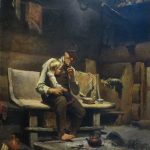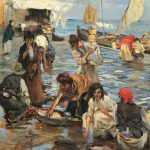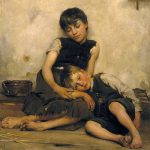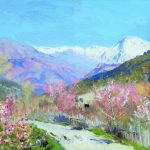Antonio Mancini, born on November 14, 1852, in Rome, Italy, was a prominent Italian artist known for his exceptional contributions to realist painting and portraiture. His life and career spanned a crucial period in the history of art, witnessing the transition from academic traditions to the emergence of more experimental and expressive styles.
Early Life and Artistic Beginnings:
Antonio Mancini’s early life was marked by struggles, providing a backdrop that would shape his artistic sensibilities. Born into a humble family, he showed an early aptitude for drawing, catching the attention of local artists and patrons. Recognizing his talent, his family managed to secure him a place at the Institute of Fine Arts in Rome, where he began formal art training at the young age of eight.
Under the guidance of his instructors, Mancini demonstrated a remarkable ability to capture the essence of his subjects with a depth and intensity that belied his age. His early works revealed an innate talent for observation and a keen understanding of anatomy, laying the foundation for his later mastery of portraiture.
The Influence of the Macchiaioli Movement:
In the late 19th century, Mancini became associated with the Macchiaioli, a group of Italian painters who rebelled against academic traditions, opting for a more naturalistic and plein-air approach. Mancini’s exposure to this movement, characterized by loose brushwork and an emphasis on light and color, left an indelible mark on his artistic philosophy. This influence would be particularly evident in his later works, where he seamlessly blended realism with elements of impressionism.
Recognition and Travel Abroad:
Mancini’s burgeoning talent gained recognition, and he received accolades for his early works. Encouraged by his success and seeking further artistic growth, Mancini embarked on a journey that took him to various European cities. He spent significant time in Paris, absorbing the diverse art scene and engaging with avant-garde movements.
During his travels, Mancini’s style evolved as he incorporated new techniques and perspectives into his work. His palette expanded, embracing a richer array of colors, and his brushstrokes became bolder and more expressive. This period of exploration laid the groundwork for Mancini’s mature style, characterized by a unique fusion of realism and impressionism.
Mastery of Portraiture:
One of Mancini’s most enduring legacies is his mastery of portraiture. His ability to capture the character and emotional depth of his subjects set him apart as a leading portraitist of his time. Mancini’s portraits went beyond mere physical likeness; they delved into the psychological nuances of the individuals he painted.
Among his notable portraits is the renowned “Il Saltimbanco” (The Acrobat), a striking portrayal of a traveling circus performer. This painting exemplifies Mancini’s ability to infuse ordinary subjects with a sense of dignity and pathos. His portraits often featured individuals from the margins of society, giving them a voice and presence in the artistic narrative.
Struggles with Mental Health:
Despite his artistic success, Mancini’s personal life was marred by mental health challenges. Throughout his career, he grappled with periods of emotional turmoil, leading to bouts of depression and erratic behavior. These struggles, while deeply personal, also found expression in his art. Some art historians posit that Mancini’s ability to convey raw emotion in his works may have been influenced by his own internal battles.
Return to Italy and Later Years:
In the early 20th century, Mancini returned to Italy, where he continued to paint prolifically despite his mental health challenges. He received numerous awards and honors, solidifying his reputation as a leading figure in Italian art. Mancini’s work was featured in major exhibitions, both in Italy and internationally, contributing to the growing recognition of his artistic legacy.
As the years passed, Mancini’s style continued to evolve. His later works, characterized by a more introspective and contemplative quality, reflected a deepening of his artistic vision. Despite facing financial difficulties and the challenges posed by his mental health, Mancini remained dedicated to his craft until the end of his life.
Antonio Mancini passed away on December 28, 1930, leaving behind a body of work that continues to captivate art enthusiasts and scholars alike. His legacy endures not only in the brilliance of his paintings but also in the profound impact he had on the evolution of portraiture and realism in Italian art. Mancini’s ability to infuse his art with emotion and humanity transcends the boundaries of time, ensuring his place among the great masters of the late 19th and early 20th centuries.






